A blog from the perspective of the Curator, Jan Freedman, Plymouth City Museum and Art Gallery highlighting risks to collections, in particular natural science, and how UK museums can help each other to solve problems, identify and prevent risk.
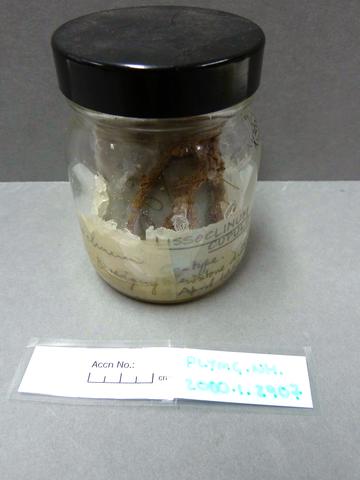
Type specimen of a spoon worm in the spirit collections at Plymouth City Museum and Art Gallery. The specimens was discovered in the collection after a collections review, and has since been fully conserved].
Displays, outreach events, research, conservation and talks are some of the well-promoted, glamorous work a museum curator may have to carry out. Even less exciting tasks like documentation, digitisation, databasing, and cleaning storerooms are mentioned in blog posts and publicity.
Being a museum curator is incredibly fascinating, rewarding and exciting, but it is not without risks.
The one thing that underpins every curator’s work is, of course, the collections. From the smallest insect to the largest fossil, natural history curators often care for the most diverse types of collections in a museum.
Natural history curators care for large and small specimens. Entomology collections can number in their thousands.
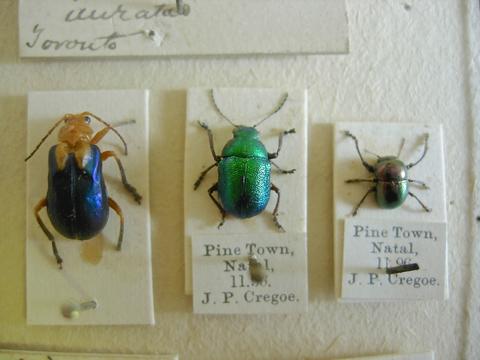
Image © Plymouth City Museum and Art Gallery]
Curators have a responsibility for all the collections in their care and this can be a surprisingly risky business. Behind closed doors, curators are ensuring the safety of the nation’s historic treasures so they can be used and enjoyed both today and in the future.
Risks to collections have traditionally been called the ’10 agents of deterioration’ (although I will argue for one more). These are the main threats to collections and all curators are trained to ensure that specimens, whether in the store room, on display or on loan, are safe.
The 10 agents
The risks can be broadly grouped into three categories:
- Disaster: Events that, although rare, can have catastrophic effects on museum collections (fire, flood, and physical forces)
- Unavoidable risks: Risks to specimens and collections that are naturally occurring (pests, light, temperature, and humidity)
- Avoidable risks: Risk to collections due to human activity (theft/vandalism, pollutants and custodial neglect)
Disaster
These can be the most devastating of events and can destroy entire collections.
Fire can smoother specimens in soot, and destroy labels and any paper associated with the specimen. In worst case scenarios entire collections can be lost (for example, herbaria, taxidermy, entomology). Precautions are relatively cheap and easy to implement, such as fire doors, regular fire alarm checks, annual PAT testing of electronic equipment, and clean offices and store rooms.
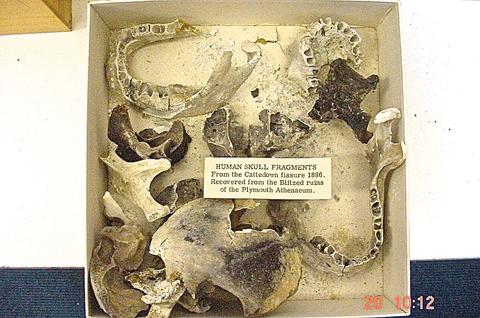
Severe bombing during the Second World War destroyed and severely damage collections across the country. These hominin remains from Cattedown, Plymouth, were rescued from a fire during the Plymouth Blitz. Image © Plymouth City Museum and Art Gallery
Flooding is, sadly, a fairly common disaster, mainly due to old pipe systems in many museums. Burst pipes and blocked drains are the main causes of floods. It can also occur after a fire due to sprinkler systems or from water used to extinguish fires. Labels can peel off specimens, become unreadable or break apart. Many specimens will need extremely careful conservation. Flooding is unpredictable and can happen anywhere. Precautions need to be in place for this type of disaster (see Disaster Planning at the end).
Collections are at risk from physical forces on a daily basis. These can range from moving a box of specimens from one place to another to the other extreme of an earthquake. In the UK earthquakes are very rare, but they do happen. Good packaging of specimens will reduce any damage to specimens in drawers or boxes. Acid free tissue can be used to nest specimens. Plastazote (an inert closed cell cross-linked polyethylene foam) cut-outs can be used to support a specimen in a box and reduce movement.
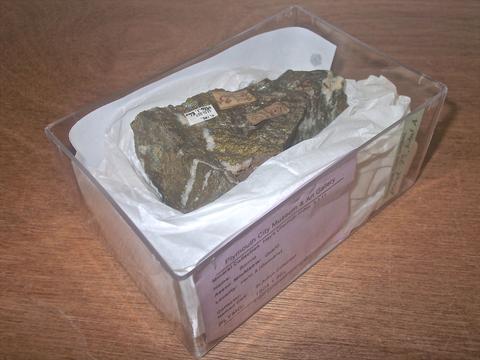
Robust specimens may be packed fairly well in clear boxes to reduce the amount of movement. Acid free tissue ‘nests’ can be made to pack specimens, or Plastazote can be cut out to hold a specimen. Image © Plymouth City Museum and Art Gallery
Unavoidable Risks
There are many risks to collections that are naturally occurring and these can have huge effects on collections. Fluctuating temperatures from changes in seasons, heating malfunctions, or simply leaving a door open, can cause damage to specimens. High temperatures can cause drying and cracking to many collections (shales, sub-fossils, taxidermy, entomology, herbaria, and others). Low temperatures can cause high humidity, which can have additional effects on the collections (see below). Controlled environments which are monitored can keep temperatures at the required levels (ideally between 15oC – 22oC).
High levels of humidity (rH), or too little, in a store room or gallery can damage collections. High humidity can cause mould growth on specimens. Low humidity can cause specimens to begin to crack. Ideal rH conditions should be between 45% and 55% (this will depend on the type of collection in the store rooms, and some collections may require slightly higher or lower humidity levels). A humidifier in the store room or gallery can assist in controlling the conditions to the required levels. Fluctuations in humidity are extremely important: rapid fluctuations are more damaging that high or low levels in themselves.
High levels of light will cause fading in taxidermy, herbaria, many entomology collections and on original labels. Generally, collections store rooms don’t have windows, and lights are only on when someone is in there. Specimens are more at risk from being on display if sunlight comes through gallery windows or there are bright lights inside display cases. Although feathers may be repainted, the original colour is permanently gone. UV filters can be placed on windows or display cases to reduce UV light levels, and using LED bulbs inside display cases can reduce fading. Regularly changing specimens on display also ensures they are not exposed to light for too long.
Pests come in all shapes and sizes and can literally eat their way through collections. Even geological collections are at risk, as pests can eat the paper labels and the glue which attaches the number to the specimen. Simple mechanisms can reduce pests. Store rooms and galleries should be kept clear of food and drink and have controlled environments which are not suitable for most insect pests. Pest traps (called museum traps) can be placed around the museum and monitored to assess the pest activity. Specimens in galleries and store rooms can show signs of pest damage, such as loss of fur or feathers or by a little pile of dust underneath the specimen (insect frass). Pests can be removed by placing the specimen in a sealed bag and freezing around -22oC for at least a week.
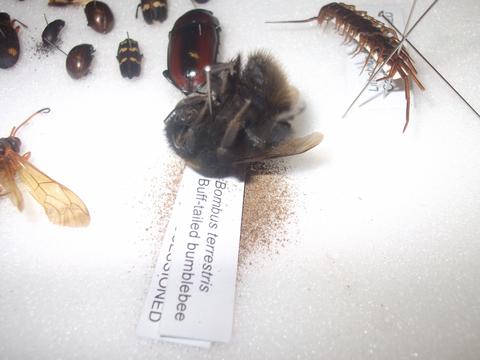
The pile under the specimen which looks a bit like sawdust, is a result of a pest eating this bumble bee from the inside. Image © Plymouth City Museum and Art Gallery
Add new comment